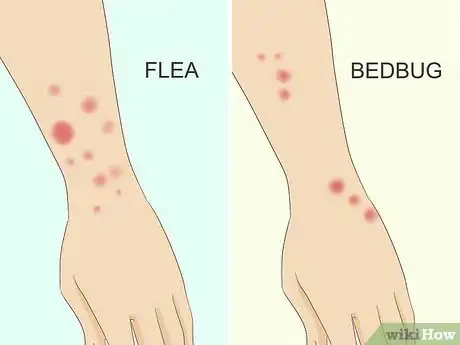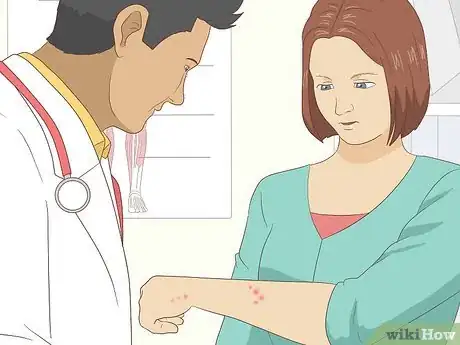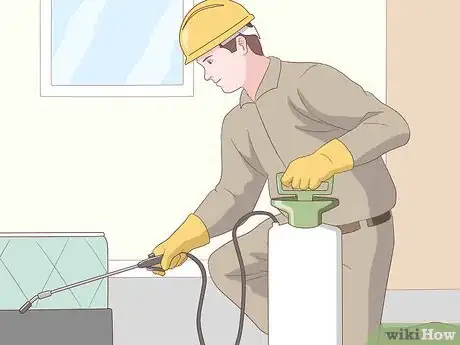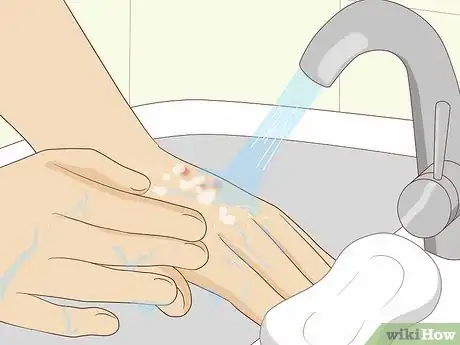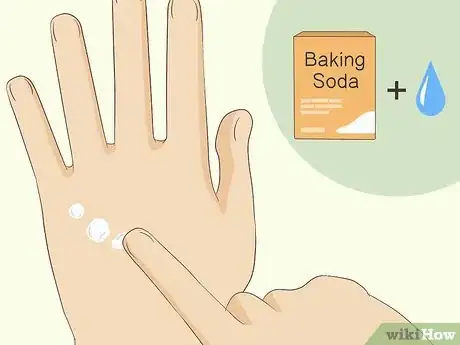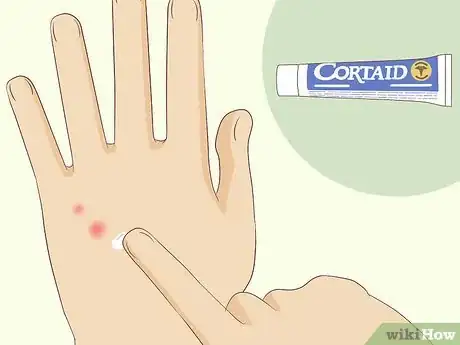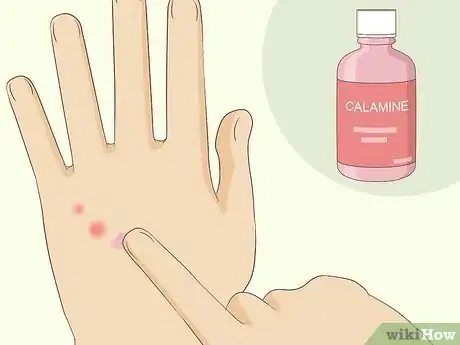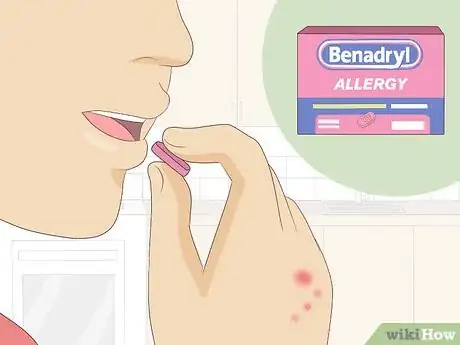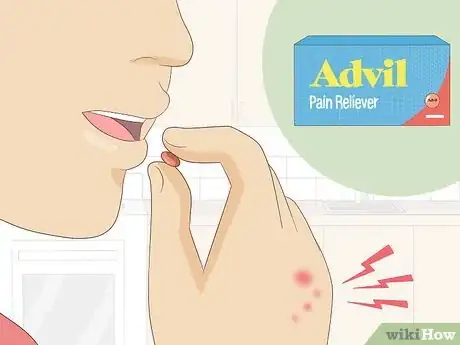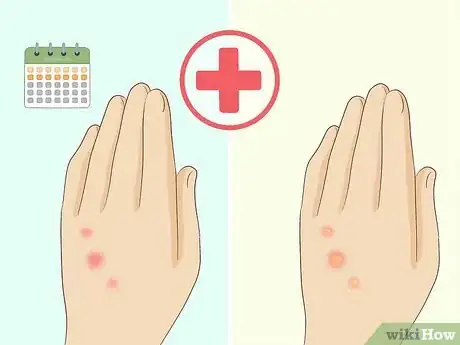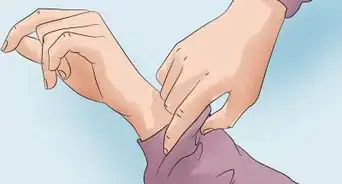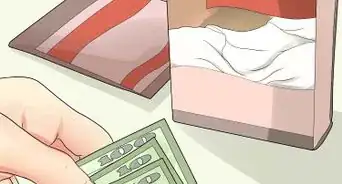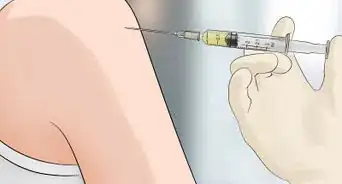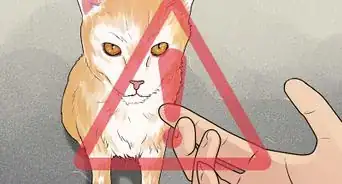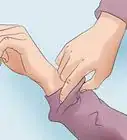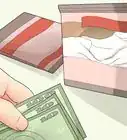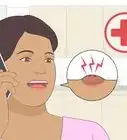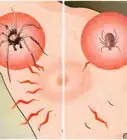This article was co-authored by Corey Fish, MD. Dr. Corey Fish is a practicing Pediatrician and the Chief Medical Officer at Brave Care, a pediatric healthcare company based in Portland, Oregon. Dr. Fish has over 10 years of experience in pediatric care and is a member of the American Academy of Pediatrics. Dr. Fish received a BS in Biology from Pacific Lutheran University in 2005, an MD from the University of Washington School of Medicine in 2009, and completed his Pediatric Residency at the University of Texas Southwestern Medical School in 2012.
There are 11 references cited in this article, which can be found at the bottom of the page.
wikiHow marks an article as reader-approved once it receives enough positive feedback. This article received 18 testimonials and 89% of readers who voted found it helpful, earning it our reader-approved status.
This article has been viewed 3,493,048 times.
Bed bugs are annoying insects that hide in soft, warm places like beds, couches, and clothing. These bugs feed on their hosts at night, leaving small bite marks that, though rarely dangerous, should be treated right away to prevent unwanted symptoms and potential allergic reactions. To prevent more bites in the future, you’ll need to get rid of your bed bug infestation completely.
Steps
Identifying a Bedbug Bite
-
1Inspect the bite marks carefully. Bedbug bites commonly resemble other insect bites, including mosquito bites and flea bites. They typically involve a raised, reddish bump but can also appear as a blister. Bedbug bites are very difficult to distinguish from other insect bites; even a clinical physician cannot usually diagnose bites simply by looking at them.[1]
- Bedbugs do, however, have a unique bite pattern. Although some bites may appear alone, most bites occur in a row of three to five bites (termed "breakfast, lunch, and dinner") or in a cluster of red bumps (a rash called bedbug dermatitis). The bites often appear in a zig-zag formation, but may appear in a straight line if the bugs bite you in the morning.
- Bites tend to occur on exposed areas of the body. Studies show that they have a preference of biting the skin around the eyelids, and such areas as the neck, face, feet, and arms. In contrast to mosquito bites, bedbug bites rarely occur on the back of the knees or in the folds of the skin.
- The bumps or the rash typically resolve themselves within one to two weeks. However, although an individual bite or set of bites may heal, if you have not eradicated the problem through pest extermination, then you may continue to get bitten. As long as there are bedbugs, they will try to get at you.
-
2Pay attention to when the bite marks occur. Consider, for example, if you notice the bites after waking up when previously you hadn't noticed them. However, this can also be difficult to determine because each person's reaction time can vary significantly. Symptoms that result from the bite can manifest at any point from a couple of hours to more than a week after the bite occurred.
- Bedbug bites can have a long incubation period. Visible signs of the bite (a red, itchy bump) can appear up to 10 days after you were initially bitten.
Advertisement -
3Check your home for signs of a bedbug infestation. Start with where you sleep, as bedbugs love bed frames, box springs, and mattresses. Bedbugs want to be where people are so they can get the warm blood of humans. A telling sign is red spots on the sheets. These may come from a bedbug that was squashed after feeding, or from the bites left on you when the bug finished feeding on you.[2]
- Inspect your mattress, box spring, bed frames, including the lining and seams. Look for sleeping adult bedbugs, carcasses, empty skins (their exoskeletons), and feces (this will look like little black spots or smudges). Check your sheets, pillowcases, and pillows as well.
- It is very difficult to see and catch a living bedbug. Adult bedbugs are tiny reddish-brown insects with broad, oval-shaped bodies. They are very good at hiding. However, finding adult bedbugs is the only way to confirm that a bedbug is what bit you.[3]
- Bedbug infestations can be stressful. Try not to worry because this is a common, treatable problem.
Alternative: If you've recently traveled, the bedbugs may have been in your hotel room. However, keep in mind that it's easy to bring bedbugs home in your suitcase or clothing, so you may have accidentally started a bedbug infestation.
-
4Visit a health-care provider. You can also see a doctor for a diagnosis if you do not find signs of bedbugs in your bed and cannot identify the source of the bites or rash. However, there is a very good chance that your physician will not be able to firmly diagnose that you have been bitten by a bedbug because the symptoms look so similar to those that result from other insect bites and skin conditions. Nevertheless, you may feel comforted by going to see your doctor, who can confirm for you that bedbugs pose little physical threat to humans.
- If you're going to the doctor, keep a close record of anything you've done to treat the bites, including what you've put on them and how often.[4]
- Your doctor may prescribe a topical corticosteroid ointment to help relieve itching and inflammation. These ointments are stronger than the ones you can buy over the counter.
-
5Call a pest control company to check for a bedbug infestation. This is the surest way to confirm that you have been bitten by a bedbug. A pest control professional will search your home and be able to confirm whether or not you have a bedbug infestation on your hands.
- The pest control professional will know what to look for and can also then treat your home to remove the bedbugs and prevent future bites from occurring.
- Home foggers and bug sprays will not usually kill a bedbug infestation.[5] To make sure you eradicate bedbugs from your home, go with a professional exterminator.
Treating Bedbug Bites
-
1Wash the bites with soap and water. Wash the area with mild soap and water; use a bar of soap and enough water to wet the surface of your hands. Work the soap in your hands into a thick, soapy lather. Rub the lather over the affected area liberally. Repeat until the entire area is covered. Leave on and do not rinse. Allow the soap lather to dry over the bitten areas. You should experience immediate relief from itching.[6]
- Washing the bites with soapy water can help alleviate itchiness and prevent a skin infection.
-
2Use home remedies to relieve itching. You can try a number of the following remedies to relieve the itching associated with the bites. These all use products you probably already have on hand.
- Make a paste of baking soda and water. Slowly add small amounts of water to the baking soda and stir until you have a thick paste. Apply a thick coat of the paste to your bedbug bites. Allow the paste to dry and stay on the rash for an hour or more before washing it off with warm water.
- Saturate a cotton ball with lemon juice, St. John's Wort, or witch hazel, all of which are natural astringents. Dab at the rash with the cotton ball to help dry it out and control the itch.
- Apply the gel from an aloe plant to bedbug bites. Use pure 100% aloe vera gel. Aloe contains both antibiotic and anti-fungal properties, which can help prevent a secondary infection due to scratching.
-
3Apply a steroidal anti-itch over-the-counter (OTC) cream. A cream that contains hydrocortisone or cortisone, such as Cortaid, can reduce inflammation and itching. You can buy a 1% hydrocortisone cream from any drugstore or pharmacy. Your doctor can tell you which cream and brand is ideal for you.[7]
- Follow the package's directions to apply the cream correctly. The cream is very mild and does not cause side effects if used for a short period of time, like a week.
- You can also get a stronger corticosteroid cream with a doctor's prescription.
-
4
-
5Take oral antihistamine. Oral antihistamines, such as diphenhydramine (Benadryl), can help control the allergic reaction (the swelling and rash) associated with the bites.[10]
- Follow package instructions for proper dosages.
- Be aware that Benadryl can cause drowsiness and you should avoid driving while taking it.
- You could also try an OTC antihistamine cream that you apply topically to the affected area.
-
6Get pain relief. If the bites are causing you any discomfort or pain, you can take OTC anti-inflammatory analgesic oral medication, such as ibuprofen, naproxen, or aspirin. Discuss these options with your doctor if you have any doubt about their usage and whether these medications are right for you.[11]
- Ibuprofen (Advil) is a non-steroidal anti-inflammatory drug (NSAID). It works by reducing hormones that cause inflammation and pain in the body. It also reduces hormones that trigger fever.
- Aspirin (Acetylsalicylic Acid) is a drug that works as an analgesic, relieving pain by inhibiting pain signals in the brain. It is also an antipyretic, a drug that reduces fever. Do not give to children, however.
- Acetaminophen (Tylenol) is safer than aspirin for children and has many of the same effects as aspirin. It is not an NSAID, however, and will not reduce inflammation.
-
7Consult a health-care provider. See your doctor if your bite does not clear up within the natural course of a bedbug bite (one to two weeks). You should also see a doctor for treatment if you have any of the following:[12]
- Multiple bites
- Blisters
- Signs of skin infection (tenderness or oozing discharge)
- An allergic skin reaction (reddened, swollen skin or hives).
- Bedbug bites, like all insect bites, can become infected through excessive scratching, as underneath the fingernails lies a host of bacterial pathogens. If your bites become infected, they will appear red and swollen, feel tender, and may drain pus. Typically there will not be a fever unless a substantial area of the skin is involved. If you experience any of these symptoms, you must seek medical attention as it points to a secondary infection. Your physician may prescribe antibiotic therapy or, if the infection is mild, an antiseptic medication that you can buy without a prescription.[13] [14] [15]
- If you experience a severe allergic reaction, your doctor may want to give you an injection of an antihistamine, corticosteroid, or epinephrine (adrenaline).[16] [17]
Expert Q&A
-
QuestionWhat do I do if I wake up with a rash, but I have not been bitten?
 Chris M. Matsko, MDDr. Chris M. Matsko is a retired physician based in Pittsburgh, Pennsylvania. With over 25 years of medical research experience, Dr. Matsko was awarded the Pittsburgh Cornell University Leadership Award for Excellence. He holds a BS in Nutritional Science from Cornell University and an MD from the Temple University School of Medicine in 2007. Dr. Matsko earned a Research Writing Certification from the American Medical Writers Association (AMWA) in 2016 and a Medical Writing & Editing Certification from the University of Chicago in 2017.
Chris M. Matsko, MDDr. Chris M. Matsko is a retired physician based in Pittsburgh, Pennsylvania. With over 25 years of medical research experience, Dr. Matsko was awarded the Pittsburgh Cornell University Leadership Award for Excellence. He holds a BS in Nutritional Science from Cornell University and an MD from the Temple University School of Medicine in 2007. Dr. Matsko earned a Research Writing Certification from the American Medical Writers Association (AMWA) in 2016 and a Medical Writing & Editing Certification from the University of Chicago in 2017.
Family Medicine Physician You may have had an allergic reaction to something in your bedroom. My recommendation is to clean all of your linens immediately and find covers for your pillow and mattress that are hypoallergenic.
You may have had an allergic reaction to something in your bedroom. My recommendation is to clean all of your linens immediately and find covers for your pillow and mattress that are hypoallergenic. -
QuestionWhat can I do to prevent bed bug bites?
 Chris M. Matsko, MDDr. Chris M. Matsko is a retired physician based in Pittsburgh, Pennsylvania. With over 25 years of medical research experience, Dr. Matsko was awarded the Pittsburgh Cornell University Leadership Award for Excellence. He holds a BS in Nutritional Science from Cornell University and an MD from the Temple University School of Medicine in 2007. Dr. Matsko earned a Research Writing Certification from the American Medical Writers Association (AMWA) in 2016 and a Medical Writing & Editing Certification from the University of Chicago in 2017.
Chris M. Matsko, MDDr. Chris M. Matsko is a retired physician based in Pittsburgh, Pennsylvania. With over 25 years of medical research experience, Dr. Matsko was awarded the Pittsburgh Cornell University Leadership Award for Excellence. He holds a BS in Nutritional Science from Cornell University and an MD from the Temple University School of Medicine in 2007. Dr. Matsko earned a Research Writing Certification from the American Medical Writers Association (AMWA) in 2016 and a Medical Writing & Editing Certification from the University of Chicago in 2017.
Family Medicine Physician You can prevent bed bugs by keeping a clean bedroom and bed environment. This includes the mattress, bedding, and pillows. You may want to purchase a hypoallergenic bed and pillow cover and keep your linens clean at all times.
You can prevent bed bugs by keeping a clean bedroom and bed environment. This includes the mattress, bedding, and pillows. You may want to purchase a hypoallergenic bed and pillow cover and keep your linens clean at all times.
Warnings
- You can treat existing bites, although they typically run their course within a week or two. However, if you have not treated the infestation, you will continue to be bitten.[19]⧼thumbs_response⧽
References
- ↑ James Studdiford MD, Kathryn Conniff MD, Kathryn P Trayces MD, Bedbug Infestation, American Family Physician 2012, Oct, 1 86 (7) 653-658)
- ↑ https://www.aad.org/dermatology-a-to-z/diseases-and-treatments/a---d/bedbugs/diagnosis-treatment
- ↑ https://www.aad.org/dermatology-a-to-z/diseases-and-treatments/a---d/bedbugs/diagnosis-treatment
- ↑ Corey Fish, MD. Pediatrician & Chief Medical Officer, BraveCare. Expert Interview. 1 April 2020.
- ↑ https://www.aad.org/dermatology-a-to-z/diseases-and-treatments/a---d/bedbugs
- ↑ https://www.aad.org/dermatology-a-to-z/diseases-and-treatments/a---d/bedbugs/diagnosis-treatment
- ↑ https://www.aad.org/dermatology-a-to-z/diseases-and-treatments/a---d/bedbugs/diagnosis-treatment
- ↑ http://www.bedbugs.org/how-to-treat-a-bed-bug-rash/
- ↑ http://kidshealth.org/teen/infections/skin_rashes/bedbugs.html
- ↑ http://familydoctor.org/familydoctor/en/diseases-conditions/bedbugs/treatment.html
- ↑ http://www.medicinenet.com/bug_bite_treatment-page2/views.htm
- ↑ https://www.aad.org/dermatology-a-to-z/diseases-and-treatments/a---d/bedbugs
- ↑ https://www.aad.org/dermatology-a-to-z/diseases-and-treatments/a---d/bedbugs/diagnosis-treatment
- ↑ http://www.mayoclinic.org/diseases-conditions/bedbugs/basics/treatment/con-20026119
- ↑ GJ Goddard, R DeShazo, Bed Bugs and Clinical Consequences of their Bites, Journal of American Medical Association 2009, April 1 301 (13) 1358-1366
- ↑ https://www.aad.org/dermatology-a-to-z/diseases-and-treatments/a---d/bedbugs/diagnosis-treatment
- ↑ http://www.emedicinehealth.com/bedbugs/page7_em.htm#medical_treatment_for_bedbug_bites
- ↑ http://www.emedicinehealth.com/bedbugs/page7_em.htm#medical_treatment_for_bedbug_bites
- ↑ https://www.aad.org/dermatology-a-to-z/diseases-and-treatments/a---d/bedbugs/diagnosis-treatment
About This Article
The first thing you should do once you notice a bed bug bite is wash the area thoroughly with soap and water. Combat itchy symptoms whenever necessary by covering the bite with natural solutions like lemon juice and aloe vera gel or professional remedies like 1% hydrocortisone cream and calamine lotion. If your skin starts to swell, take oral antihistamines, and use pain relievers like Tylenol to manage any discomfort. Visit your doctor if your bite hasn't cleared after 2 weeks. For tips from our Medical reviewer on identifying bed bug bites, read on!
